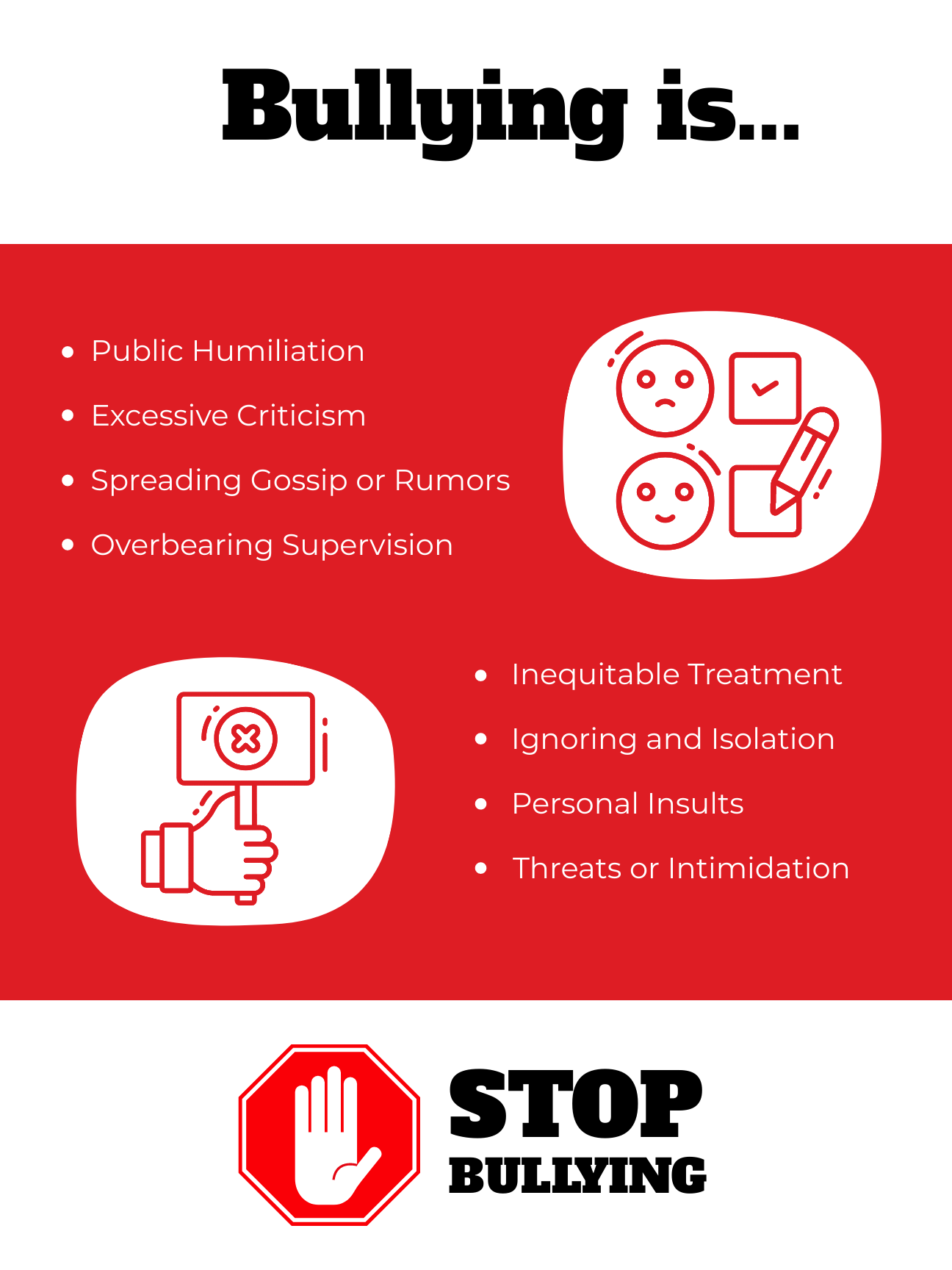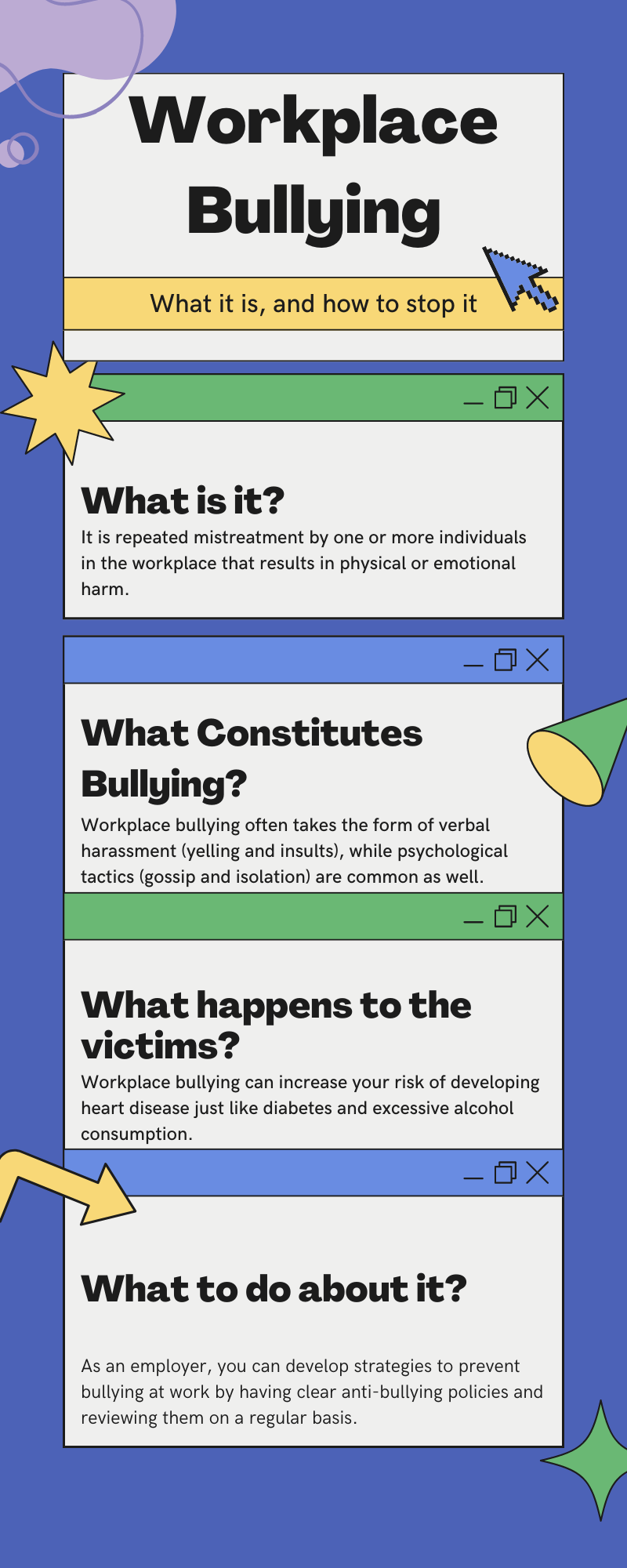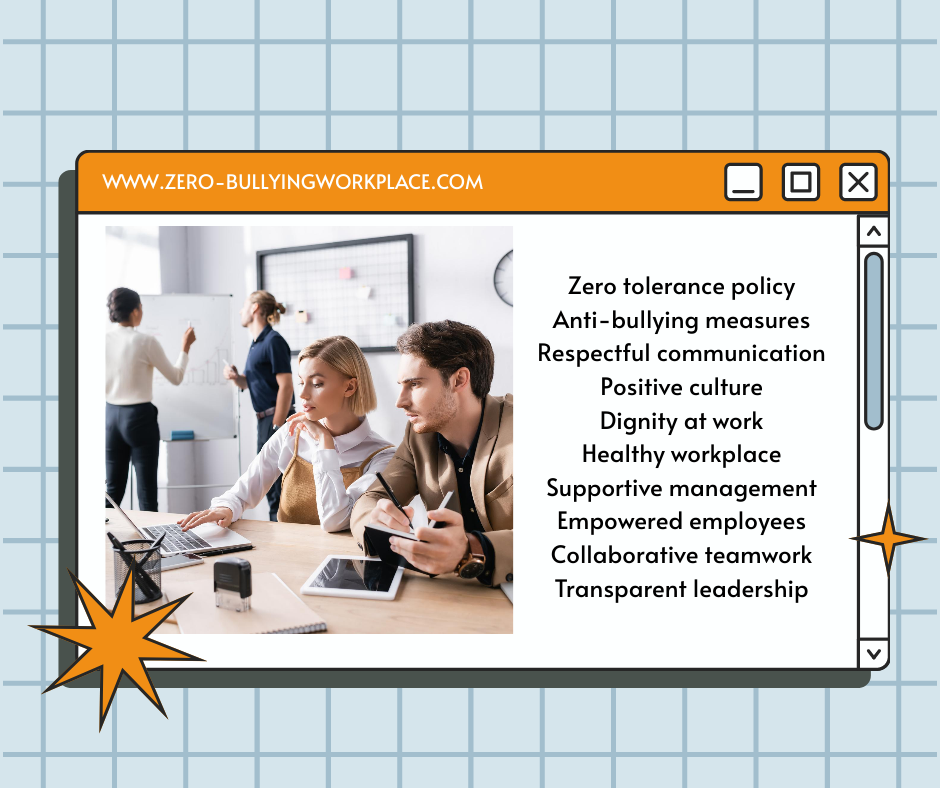How to Deal with Bullying at Work
Dealing with bullying at work is essential for preventing a hostile work environment. This comprehensive guide teaches you effective tactics and strategies for addressing and combating workplace bullying.

Workplace bullying is a serious issue that may mark a hostile work environment.
It involves abuse of power by one or more individuals in positions of authority, which can cause psychological harm and detrimentally affect the workplace.
Is Workplace Bullying Common❔
According to research, workplace bullying can increase your risk of developing heart disease, just like diabetes and excessive alcohol consumption.
A recent study shows that nearly half (49%) of Americans experience workplace bullying either directly, or indirectly through witnessing incidents. Furthermore, 66% of individuals surveyed knew that workplace bullying exists within their organization.
Some common signs of workplace bullying include verbal abuse, exclusion from social activities, constant criticism, and sabotage of work performance.
What Constitutes Bullying In The Workplace
Workplace bullying can occur in various ways, such as:
- verbal
- nonverbal
- psychological
- physical
- sexual abuse.
Verbal harassment, including yelling and insults, is the most prevalent type of workplace bullying, followed closely by psychological tactics like gossiping and isolation.

Here are some examples of behaviors that constitute hostile workplace and bullying:
- Making unreasonable demands
- Giving hostile glares and other intimidating gestures
- Yelling, screaming, and swearing
- Purposefully excluding or isolating a coworker
- Sending aggressive emails or notes
- Monopolizing supplies and other resources
- Engaging in excessive social bantering, teasing, and humiliation
- Deliberately insulting others and taking part in behind-the-back putdowns
- Monitoring another excessively
- Stealing credit from others' work.
Victims of workplace bullying may experience feelings of:
- Shock
- Anger
- Frustration and/or helplessness
- Increased sense of vulnerability
- Loss of confidence
- Emotional distress
- Burnout
- Depression
- Sleep disturbances
- Physical and mental fatigue.
In some cases, victims may feel so overwhelmed that they choose to leave their job rather than continue working in such a hostile environment.
The Bottom Line: Bullying at work is a weighty issue that can have a negative impact on employees' well-being and productivity. Dealing with workplace bullying is crucial for maintaining both physical and mental health while ensuring optimal job performance.
Effective Strategies to Combat Bullying at Work
Having strategies in place can certainly aid in managing workplace bullying by providing a framework that promotes accountability.
These strategies offer clear guidelines and actionable steps for both management and employees, ensuring a safer and healthier work environment.
How To Prevent Workplace Bullying

Education and Training
Regular training on workplace bullying awareness and prevention can help all employees understand what constitutes bullying behavior and how to report incidents.
This includes educating employees on their rights and responsibilities under company policy.
Clear Anti-Bullying Policies
Don't just write an anti-bullying policy and shove it in a drawer. Make it a living document that is disseminated and discussed regularly. Clearly define unacceptable behaviors and outline concrete consequences for bullies.
These policies must be concise and clearly outline expectations around appropriate behavior and consequences for violating those policies.
Monitor Employee Wellbeing
Regularly checking in with employees to assess their wellbeing can help detect early signs of bullying or mistreatment.
Managers should take immediate action to investigate employee concerns and provide support as necessary.
Apply time tracking
Time tracking can potentially help prevent bullying in the workplace by providing greater transparency into employee behavior and activity levels.
Managers may be able to accumulate data on employees' workload and performance and, thus, identify patterns of harassment or intimidation that would otherwise go unnoticed.
Additionally, if employees know they are being monitored through time tracking systems, this could act as a deterrent against engaging in such behaviors in the first place.
However, it should be noted that simply implementing time tracking alone is unlikely to fully address the issue of bullying in the workplace, which requires a comprehensive approach, including education, training, and enforcement of anti-bullying policies.
Leadership Example
Senior leaders must set a positive example by modeling respectful behavior and holding themselves accountable for maintaining a safe and healthy work environment.
This implies taking swift action to address any reported instances of bullying or other forms of mistreatment within the organization.

What Can I Do About Bullying At Work❔
Recognize the signs
Immediately recognizing signs of a hostile workplace is important for preventing bullying and maintaining a healthy work environment.
✅ Be aware of bullying behaviors (see infographics above), such as verbal abuse, intimidation, or exclusion.
✅ Stay vigilant and remain mindful of new incidents or signs of bullying, even after confronting the bully.
Document incidents
Recording bullying incidents allows organizations to track behavior patterns and identify repeat offenders. This can aid in prevention efforts and hold individuals accountable for their actions. Additionally, documentation can serve as evidence if legal action is taken.
✅ Keep a record of bullying incidents, including dates, times, and descriptions of what happened.
Seek support
Seeking support in workplace bullying cases is crucial for emotional healing, building resilience, and finding resources for effectively coping and addressing the situation.
✅ Talk to a trusted colleague, friend, or family member about what you're experiencing.
✅ Seek coworkers or support groups who have also dealt with workplace bullying for advice and understanding.
Confront the bully
A bully has no respect for a weakling and the way to stop a bully is not to be weak. The way to stop a bully from ever being a bully is to say: “I’m as strong as you. Anything you do to me, I can do to you.” – Margaret Thatcher, in 1982
Confronting the bully at work may not always be feasible or safe, but it can potentially stop the behavior and assertively communicate boundaries.
✅ If you feel comfortable, have a calm and assertive conversation with the bully to express how their behavior impacts you.
✅ Clearly communicate your boundaries and expectations to the bully, letting them know what behavior is unacceptable.
Seek input from HR
Involving HR in workplace bullying cases ensures proper investigation, accountability, and potential remediation measures to create a safer and fairer work environment.
✅ If the bullying continues or escalates, report the incidents to your HR department and provide documented evidence.
Practice self-care
✅ Take care of your physical and emotional well-being by engaging in activities that reduce stress and boost your mood.
Consider professional help
Considering professional help for dealing with workplace bullying can provide expert guidance, validation, and tools for managing stress, trauma, and self-care. When feeling overwhelmed or struggling to cope independently, seeking outside assistance can greatly benefit your overall wellbeing.
✅ If the bullying persists and negatively affects your mental health, consider seeking therapy or counseling.

Educate yourself
You must learn about your rights and the policies in place regarding workplace bullying to better protect yourself.
✅ Develop and practice assertiveness skills to effectively communicate and stand up for yourself in difficult situations.
✅ Set small goals to overcome the impact of bullying, such as improving your self-confidence or finding new ways to cope.
✅ Focus on your work and maintain a professional demeanor despite negative interactions with the bully.
✅ Build resilience to handle the challenges and stress that may arise from dealing with workplace bullying.
✅ Familiarize yourself with options, such as transferring departments or seeking legal advice.
✅ Consider advocating for changes within your organization to address and prevent bullying in the workplace.
✅ Stay updated on any organizational policies or procedures related to bullying and ensure you know your rights as an employee.
✅ Reflect on your behaviors and actions to ensure you are not contributing to a negative work environment.
✅ Acknowledge and celebrate your achievements to combat stress and remind yourself of your worth.
Parting Thought
By implementing these strategies, we can foster a work environment where everyone feels empowered to speak up, diverse perspectives are valued, and collaboration thrives.

Create safe spaces for employees to report bullying, whether it's an anonymous hotline, a trusted HR representative, or an employee advocacy group. Ensure investigations of hostile work environment cases are prompt and confidential.
